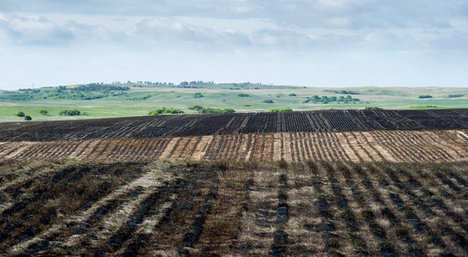 “A grassland field in North Dakota that was burned and then seeded with soybeans. More than one million acres have become farmland in the state since 2007.” Source of caption and photo: online version of the NYT article quoted and cited below.
“A grassland field in North Dakota that was burned and then seeded with soybeans. More than one million acres have become farmland in the state since 2007.” Source of caption and photo: online version of the NYT article quoted and cited below.
(p. A13) By guaranteeing income, farmers say, crop insurance removes almost any financial risk for planting land where crop failure is almost certain.
“When you can remove nearly all the risk involved and guarantee yourself a profit, it’s not a bad business decision,” said Darwyn Bach, a farmer in St. Leo, Minn., who said that he is guaranteed about $1,000 an acre in revenue before he puts a single seed in the ground because of crop insurance. “I can farm on low-quality land that I know is not going to produce and still turn a profit.”
. . .
Environmentalists, hunting groups and even some farmers say the prospect of expanding insurance will only speed the push to turn grasslands into farms.
. . .
The existing crop insurance subsidy ballooned to $7.3 billion last year from $951 million in 2000, or about $1.2 billion adjusted for inflation, according to another G.A.O. report released in April. The costs of the program have risen as the value of crops has increased. Over the next 10 years, a Congressional Budget Office study estimates, the premium subsidy for the existing program will cost about $90 billion.
“This is better than a government bailout,” said Steve Ellis, vice president of the Taxpayers for Common Sense, a budget watchdog group in Washington. “A bailout is a one-time thing when something bad happens. But crop insurance keeps giving, good or bad. And it’s about to give even more.”
For the full story, see:
RON NIXON. “Amid Growth, Plan to Insure Risks on Crops.” The New York Times, First Section (Thurs., June 7, 2012): A1 & A13.
(Note: ellipses added.)
(Note: the online version of the article has the date June 6, 2012 and has the title “Crop Insurance Proposal Could Cost U.S. Billions.”)
